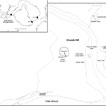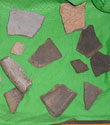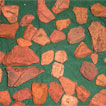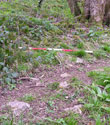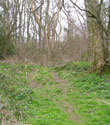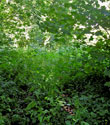Background
In 2006, Mrs Helen (Philippa) Grove reported to the Trust that she had found Roman pottery and building material in Park Wood near her home on Gower. Steve Sell, our Finds Liaison Officer, went out to have a look, and he was staggered by the amount of pottery and tile that she had collected, which is much more than what is known from other Roman sites on Gower. It had all been collected from in and around a small enclosure known as Church Hill. However, it was the middle of the summer, and the site was so overgrown that he couldn´t see anything but brambles and other vegetation. It was not until the following Easter that we managed to have a look at the site properly, and wrote a short report that we sent to Cadw, recommending that the site should become a Scheduled Ancient Monument. We also contacted the Forestry Commission, which owns Park Wood.
Following negotiations between Cadw, the Forestry Commission, the Trust and Swansea University, the site was scheduled and an excavation was arranged to find out more about it. We also wanted to know whether the track that runs across the enclosure had done a lot of damage to the archaeology underneath. Cadw provided a grant for the work, so at the end of June 2008 a group of students from the Department of Classics, Ancient History and Egyptology at the university, with their head of department Dr Eddie Owens, joined Dr Edith Evans, who was leading the excavation for the Trust, and Rowena Hart who was in charge of a new survey. Also taking part were a student from Brussels who was just finishing a three-month placement with the Trust, Bernice Cardy, a stalwart of the Royal Institution of South Wales who was in charge of washing the pottery, and another volunteer.
Read the Dig Diary to find what the students felt about it all!

